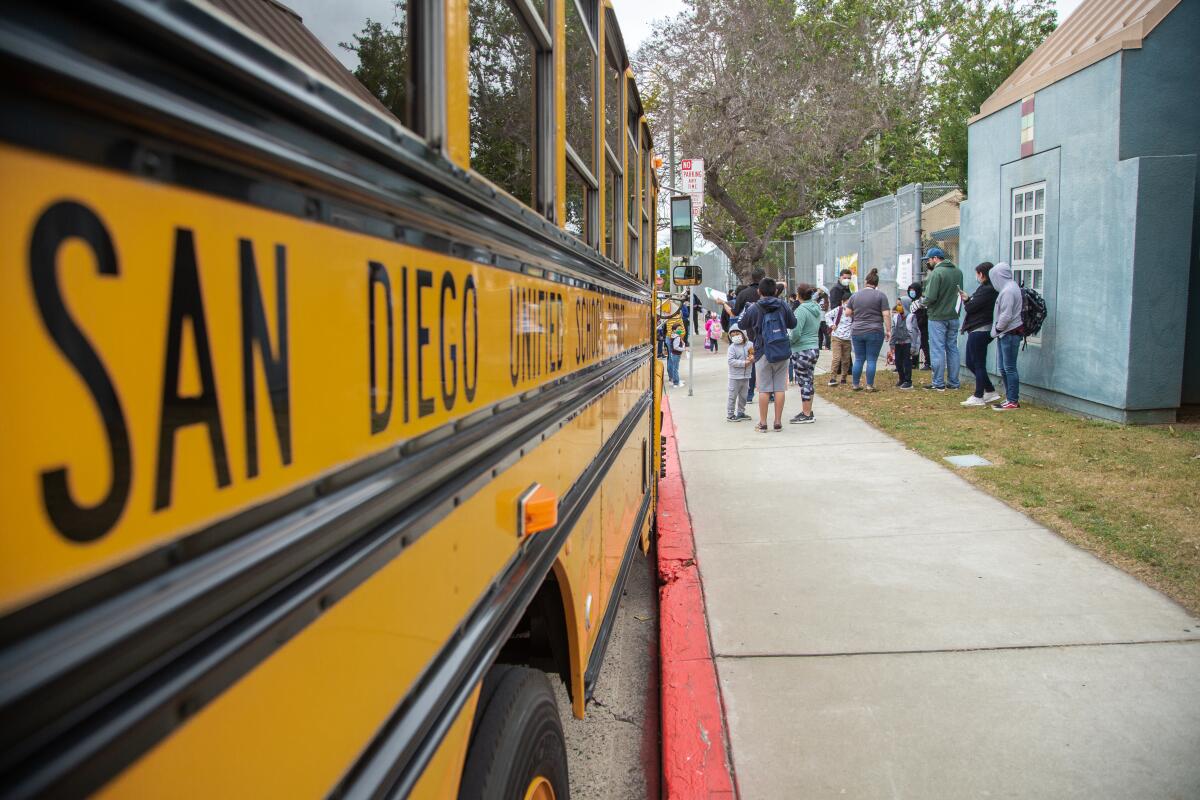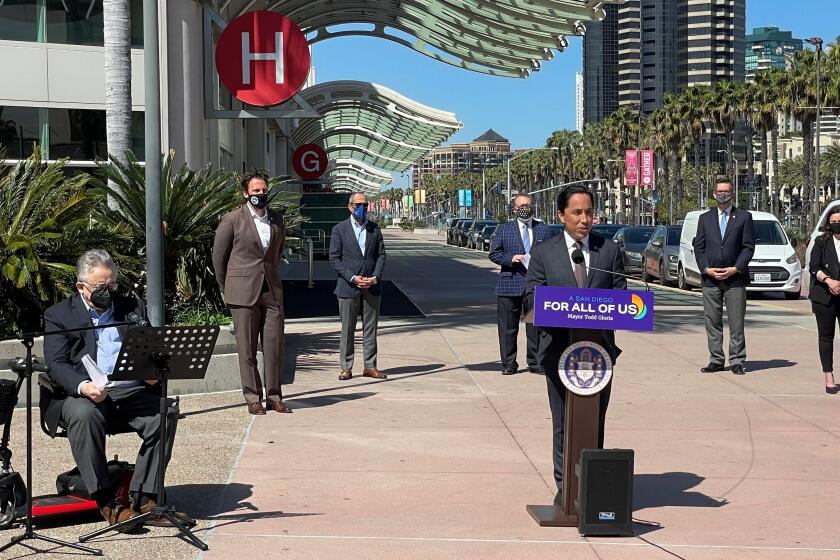Hiring shortages and COVID complicate schools’ year of recovery

- Share via
SAN DIEGO — This was supposed to be a recovery year for schools and for students.
But it doesn’t always feel like it for Jennifer Davis, who teaches seventh-graders at the Language Academy near San Diego State University.
Often there aren’t enough teachers or substitutes to teach classes, she said, so sometimes the librarian has to take over a class and the school library must close, or the assistant principal takes a class and there’s nowhere to send students who are having a tough day or acting out.
Some of her students seem to have forgotten how to be in class, Davis said; they are having a harder time focusing, they are more antsy, tune out more easily and become discouraged more easily.
School staff are identifying more special needs in students, so Davis is spending a lot of time filling out special education paperwork, she said.
And it doesn’t help that the school’s middle school students have one counselor only three days a week, Davis said.
“I think so many of us thought there was going to be more normalcy,” Davis said of the year back after COVID closures. “However it’s ... just every bit as exhausting as last year.”
This year was meant to be the year that schools help students catch up academically after more than a year of distance learning. Schools also are expected to help students heal emotionally from the traumas of the pandemic and school closures last year.
Federal and state leaders have poured hundreds of millions of dollars into schools so they can expand academic programs, hire new staff and increase mental health and other services for students.
But teachers say it has been harder than expected to help students recover, largely because of school staffing shortages across the country.
In some cases, the shortages of substitutes and other staff are forcing schools to combine classes or go over class-size maximums. Specialists hired specifically to give struggling students extra time and attention are instead being pulled away to teach general classes because there aren’t enough substitute teachers. Schools in some cases have been putting multiple classes together in an auditorium, cafeteria or library, where they are being supervised but not taught, said Kisha Borden, president of the San Diego Unified teachers union.
“We were all thinking, ‘Okay, we’re all going to be back in person, we’ll be with our students face to face, we can work on building that community,’” Borden said. “Unfortunately, teachers are feeling like they don’t have a lot of time to tend to the social-emotional health of the students.”
The San Diego teachers union is filing grievances against the district, she said, because class sizes and teachers’ special education caseloads are exceeding the limits set in their contract.
As of early November, 65 middle and high school core classes were over the district’s limit of 36 students per class at 12 schools, Borden said.
That’s an improvement from the month before, when there were 104 core classes at 12 schools over the maximum.
Some school principals were able to lower class sizes by rearranging class schedules, Borden said.
San Diego Unified has tried addressing the staffing shortage by offering higher pay to entice permanent substitute teachers who’ll commit to working at one school. The district also is offering a $4,000 hiring incentive for special education teachers.
Even with those incentives, the district still has vacancies for both kinds of positions, Borden said.
District officials last week did not disclose numbers of vacancies at schools when asked by the Union-Tribune.
“We’re up against the same challenges that I think employers across the economy are up against, which is just there’s a scarcity of people available who are willing to come to work,” said Richard Barrera, president of the San Diego Unified School Board.
Kristin Brown, an educator of 29 years who teaches first grade at Silver Gate Elementary, typically has a handful of students who struggle below grade level; but this year, more than half of her 22 students are struggling, she said.
“They really need someone one-on-one, and I can’t do one-on-one with 22 kids, not even 12 kids,” she said.
It’s been even more difficult for Brown to help all her students because students are absent so often due to COVID, she said, noting that it wasn’t until the 43rd school day this year that all her students were in attendance.
Students have been absent weeks at a time because they or their family members tested positive for the coronavirus, Brown said. When students have even minor symptoms, like a runny nose, they have to stay home until they get a negative coronavirus test.
Every time students are absent, Brown has to reteach what they missed, she said, which takes up more of her time.
Brown’s school has a resident substitute teacher, but more than one teacher is often absent.
Brown said she hasn’t taken any days off this year because she isn’t confident there would be a substitute available to take over her class.
Many San Diego Unified teachers say they are more stressed than usual because, while they are tasked with helping students recover, they also are being asked to implement multiple new district initiatives, such as new grading practices and a new literacy test.
Teresa Ang, a theater teacher at Mann Middle School, put it this way, “We’ve all been traumatized by COVID, and yet the teachers are expected to come back and just do the same old thing they did before, and then we’re going to add a whole bunch more on top of it.”
More to Read
Sign up for Essential California
The most important California stories and recommendations in your inbox every morning.
You may occasionally receive promotional content from the Los Angeles Times.











